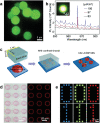Thermally Activated Delayed Fluorescent Gain Materials: Harvesting Triplet Excitons for Lasing
- PMID: 35344285
- PMCID: PMC9165517
- DOI: 10.1002/advs.202200525
Thermally Activated Delayed Fluorescent Gain Materials: Harvesting Triplet Excitons for Lasing
Abstract
Thermally activated delayed fluorescent (TADF) materials have attracted increasing attention because of their ability to harvest triplet excitons via a reverse intersystem crossing process. TADF gain materials that can recycle triplet excitons for stimulated emission are considered for solving the triplet accumulation problem in electrically pumped organic solid-state lasers (OSSLs). In this mini review, recent progress in TADF gain materials is summarized, and design principles are extracted from existing reports. The construction methods of resonators based on TADF gain materials are also introduced, and the challenges and perspectives for the future development of TADF gain materials are presented. It is hoped that this review will aid the advances in TADF gain materials and thus promote the development of electrically pumped OSSLs.
Keywords: electrically pumping; gain material; organic solid-state laser; reverse intersystem crossing; thermally activated delayed fluorescent.
© 2022 The Authors. Advanced Science published by Wiley-VCH GmbH.
Conflict of interest statement
The authors declare no conflict of interest.
Figures





References
-
- Maiman T. H., Nature 1960, 187, 493.
-
- Brock E. G., Csavinszky P., Hormats E., Nedderman H. C., Stirpe D., Unterleitner F., J. Phys. Chem. 1961, 35, 759.
-
- Kuehne A. J., Gather M. C., Chem. Rev. 2016, 116, 12823. - PubMed
-
- Sorokin P. P., Lankard J. R., IBM J. Res. Dev. 1966, 10, 162.
-
- Soffer B. H., McFarland B. B., Appl. Phys. Lett. 1967, 10, 266.
Publication types
Grants and funding
LinkOut - more resources
Full Text Sources
